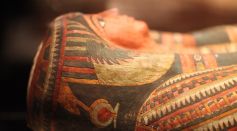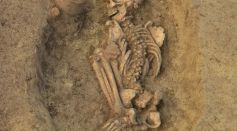Tags: Genetics

Scientists Reconstructed the Faces of 3 Egyptian Mummies Using Ancient DNA Extracted From Their Bodies

Long-Term Asexual Reproduction Discovered for the First Time in a Prehistoric Species
Baylor College of Medicine Developed a Novel Approach to Select Subjects for Gene Experiments More Convenient and Faster than Fruit Fly Screening Method
Kuruma Shrimp Genome Provides Genetic Resource of Immune-Related Genes for Fisheries Management
Classic Tabby Cat Stripes: Where Does It Come From?
Protein Cell P53 Drug on Clinical Trials; To Restrore Cancer-Depleting Cell Function

Sickness While Aging: Research on Genetics Cites Other Factors of Falling Ill Than Getting Older
Genetic Analysis Uncovers Unexpected Evolution Flexibility of Bowfin Fish; Presents Better Model for Human Evolution
Endometriosis Cause, Potential Treatment Identified in New Research; Genetic Analyses Conducted for Results

Archaeogenetics in Croatia's Neolithic, Bronze Age Possible Missing Piece of European Ancestry

Comparisons of Multiple Strains of Cacao Trees Provide Insights on Genomic Structural Variants Responsible for Plant Diversity
DNA Helix Torsional Stiffness Measured Through a Novel Technique to Understand How Cells Work
Daddy Long Legs Genetically Engineered to Get Shorter Legs! Here's How Experts Tinkered With These Harvestmen's Genetics

Human Height Influenced by Specified Genes in Growth Plates During Early Childhood

AI Innovation 'AlphaFold' May Lead to Human Proteome Revolution!
How The Transcription Factor Guides the DNA in Specialized Cell Development

1,600-Year-Old Sheep Mummy Reveals Husbandry Practices in Ancient Iran

Genetic Markers That Control Sunflower Oil Traits Discovered in New Study

Mr. Frosty Inspires Discovery: Leopard Geckos Got Bright Colors from Cancer Gene
CRISPR Trial Successful Against Transthyretin Amyloidosis, Deactivates Genes of Untreatable Disease
Most Popular

Solar vs Wind vs Hydro Energy: Which Renewable Energy Is Most Effective Power Source?

Carbon Footprint 101: What It Is and Simple Ways to Reduce Yours

How Satellite Technology and Earth Observation Are Transforming Modern Life

How Ice Cores Reveal Climate History: Insights from Paleoclimate Science and Ancient Data




